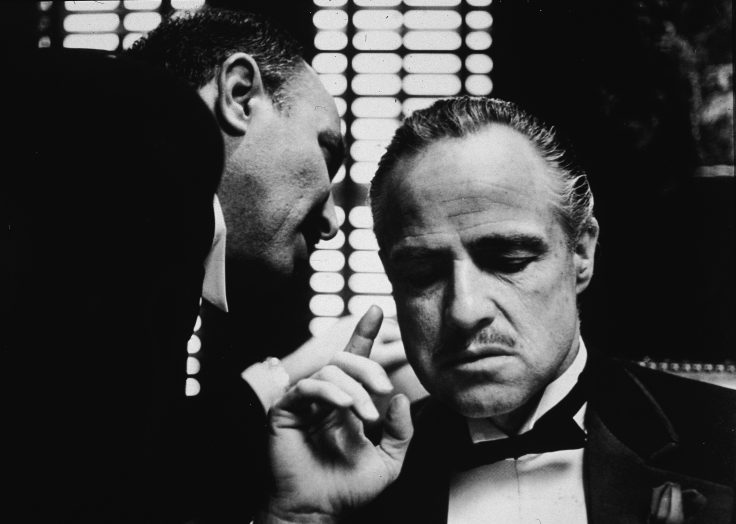Once each decade since 1952, Sight & Sound, a noted British film magazine, publishes a poll in which it asks top critics to name the "greatest films of all time." Not surprisingly, most of the lists have consisted in the main of high-class critics’ darlings like Battleship Potemkin, Citizen Kane, and The Rules of the Game, but in 2002 a pair of ringers, The Godfather and The Godfather Part II, got slipped into the deck. It’s hard for me to imagine that anyone in his right mind would have foreseen in 1972 that Francis Ford Coppola’s screen version of Mario Puzo’s 1969 novel about a New York mob family would come to be regarded as a classic, but so it has, and Mark Seal’s Leave the Gun, Take the Cannoli tells the story of how The Godfather came to pass in a way that is both thorough and straightforwardly readable.
What makes the transformation of The Godfather into a Great Movie so unexpected is that Puzo’s novel didn’t pretend to be anything more than a piece of page-turning pulp fiction, complete with sex scenes galore—and that Coppola’s movie follows it closely. Even the dialogue derives in large part from the book (though not the unforgettable line that Seal lifted for his perfect title, which was improvised on the spot by Richard Castellano).
Fascinated though I was by Seal’s well-told tales of the vast amount of collective effort that it took to bring The Godfather to the screen, the best things about Take the Gun are for me the sections in which we learn how Coppola, who cowrote the screenplay with Puzo, performed the feat of alchemy so neatly described by Pauline Kael in her New Yorker review of the film: "Francis Ford Coppola … has stayed very close to the book’s greased-lightning sensationalism and yet has made a movie with the strength that popular novels such as Dickens’ used to have."
Some of it, of course, was due to the casting of Marlon Brando, James Caan, Robert Duvall, and Al Pacino in the principal roles. In 1972 Brando was generally regarded in Hollywood as a has-been, while his supporting colleagues were little-known journeymen actors. Paramount resisted all five men stalwartly. Yet they were Coppola’s first choices, and it is now impossible to imagine the film without them. Indeed, Caan, Duvall, and Pacino became full-fledged stars as a result of The Godfather, while Brando’s career was instantaneously revitalized by his richly layered performance as Don Vito Corleone, the patriarch of an all-American family of thieving murderers.
"Family" is the operative word. As Coppola later explained:
I realized that there was the core of a profound story, one of a classic succession concerning a great king with three sons, each of whom had a single element of what made the king great….The oldest was given his passion and aggressiveness, the second his sweet nature and child-like qualities, and the third his intelligence, cunning, and coldness.
To this he added an element only implicit in the novel, one that Puzo singled out when he wrote, "The Godfather was a romanticized version of what the Mafia is like. They’re really not that nice." The warmth with which Coppola portrays the Corleones—and which is enhanced by Gordon Willis’s chiaroscuro-rich, almost Rembrandt-like cinematography—completes the transformation of the novel into a tale of a close-knit Italian-American family whose male members just happen to kill and steal for a living, save for which they might be just like you and me. Little wonder that lines from the movie, most notoriously "I’ll make him an offer he can’t refuse," were embraced wholeheartedly by real-life Mafiosi who knew a good thing when they heard it.
The best scene in the movie is, accordingly, the climactic sequence, in which Pacino’s Michael Corleone, who has replaced his father as head of the family, carries out his posthumous bidding by simultaneously killing off all the men responsible for the attacks on Don Vito and Sonny (played by Caan), Michael’s older brother, crosscutting between their gory assassinations and an altarside scene in which Don Michael becomes official godfather to the son of his traitorous brother-in-law, taking a sacred vow to "renounce Satan and all his works" as Bach’s C Minor Passacaglia plays in the background. It is pure cinema, the stuff Sight & Sound critics’ poll votes are made of—and it is drenched in blood. It is also the embodiment of what Al Ruddy, producer of The Godfather, meant when he said, "There is one reason that film is successful and one reason only. It may be the greatest family movie ever made." Dickens would have been proud.
Leave the Gun, Take the Cannoli: The Epic Story of the Making of The Godfather
by Mark Seal
Gallery Books, 448 pp., $28.99
Terry Teachout is the drama critic of the Wall Street Journal and the critic-at-large of Commentary. Satchmo at the Waldorf, his first play, has been produced off Broadway and by theater companies from coast to coast.
